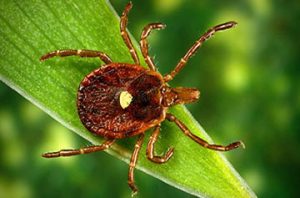Now for the science-y part of this post. (I suggest you re-read Part l. Can’t hurt. Might help.)
If you’ve read our other posts on the blacklegged tick (aka the deer tick), you might guess—and rightly so—that it’s the tick that’s been on our radar the longest; the one we (still) give most of our time and attention to. And all for good reason.
Sheer numbers (how much Lyme disease we’ve seen; what the co-infections are and how commonplace they are; its reputation as the “great imitator”) keep the blacklegged tick in the spotlight. Meanwhile, with the exception of Long Island, the lone star tick is rarely seen in the metro New York area and points north. But it has colonized some islands off Connecticut and established a toehold on Cape Cod in Massachusetts.

Indeed, the lone star tick’s potential for harm could, somewhere down the pike, become a force all northerners face.
And consider this: though deer serve as a great food source and taxi service for ticks, they are immune to Lyme disease. Not so with the lone star tick. Because given the right circumstances, it can kill even deer.
So … what diseases or conditions does this tick carry—and could any be fatal to people? Here’s the short list:
- Ehrlichiosis is nasty. Upward of two percent of those who get it might die.
- Tularemia is nasty too, though less so than ehrlichiosis.
- Heartland virus is rare—and most people who do get it have mild symptoms; perhaps none at all. But yes, some will die.
- Alpha-gal syndrome? Perhaps—especially if you don’t know it for what it is. While the symptoms can be frighteningly intense, not everyone reacts with that same level of intensity. Plus this syndrome’s transcontinental spread in places lacking lone star ticks leads to yet-unanswered questions.

So how about STARI, or southern tick-associated rash illness—can it do you in? My careful search turned up zilch, zip, zero. Doesn’t mean STARI won’t send you to an early grave. But if it could, I can’t find credentialed scientific sources to back up such a claim. You’ll be interested to know, though, that the rash STARI stands for can, on the surface of things, make you think you might have Lyme disease. And more unanswered questions: as of August 2017, the pathogen that causes STARI remains unknown.
Sources:
- ct.gov/caes/lib/caes/documents/publications/press_releases/2017/caes_deep_press_release_lone_star_ticks.pdf
- cdc.gov/ehrlichiosis/symptoms/index.html
- cdc.gov/mmwr/volumes/66/wr/mm6633a5.htm
- livescience.com/56674-death-from-heartland-virus.html
- med.unc.edu/medicine/news/chairs-corner/podcast/alpha-gal
- niaid.nih.gov/news-events/differentiating-lyme-disease-stari